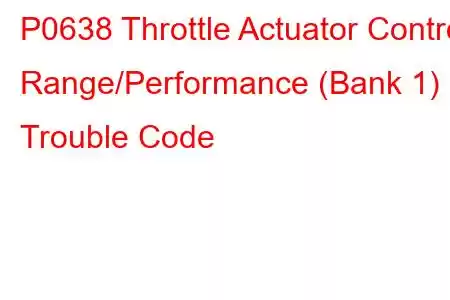P0638 Throttle Actuator Control Range/Performance B1
OBD-II Trouble Code Technical Description
Throttle Actuator Control Range/Performance (Bank 1)
This diagnostic trouble code (DTC) is a generic OBD-II powertrain code. It is considered generic because it applies to all makes and models of vehicles (1996-newer), although specific repair steps may vary depending on the model.
What does that mean?
Some newer vehicles are equipped with drive by wire systems - where the throttle body is controlled by a sensor on the gas pedal, the Powertrain Control Module / Engine Control Module (PCM/ECM), and an electric actuator motor in the throttle body.
The PCM/ECM uses the throttle position sensor (TPS) to monitor the actual throttle blade position and when the actual position is out of range with the target position, the PCM/ECM will set the DTC P0638. Bank 1 refers to the side of the engine with cylinder number one, however most vehicles use one throttle body for all cylinders. This code is similar to code P0639.
Most throttle bodies of this type are not serviceable and need to be replaced. The throttle body is spring actuated to hold at an open position in the event of a motor failure, in some cases with a complete failure the throttle will be unresponsive and the vehicle will only be capable of driving at a slow speed.
Note: If there are any DTC codes associated with the throttle position sensor, be sure to correct those before diagnosing the P0638 code.
Symptoms
Symptoms of a P0638 trouble code may include:
Check Engine Light illuminated (Malfunction Indicator Lamp) The vehicle may feel like it hesitates on accelerationPotential Causes
Causes of this DTC may include:
Pedal position sensor malfunction Throttle position sensor malfunction Throttle actuator motor malfunction Dirty throttle body Wiring harness, loose or dirty connections PCM/ECM MalfunctionDiagnostic / Repair Steps
Pedal position sensor - The pedal position sensor is located on the gas pedal. There are usually three wires used to determine the pedal position, a 5 volt reference supplied by the PCM/ECM, ground, and sensor signal. A factory wiring diagram will be necessary to determine which wire is used. Make sure the connection is secure and there are no loose wires in the harness. Check for good ground using a digital volt ohm meter (DVOM) set to the ohms scale by connecting one lead to the ground at the sensor connector and the other to chassis ground - resistance should be very low. Check for 5 volts reference voltage from the PCM by using the DVOM set to volts scale with the positive lead at the wiring harness connector and the negative lead on a known good ground with the key in the run or on position.
Check for reference voltage using the DVOM set to volts scale with the red lead on the reference signal and the negative lead on a good known ground with the key in the run / on position - the signal voltage should increase as the gas pedal is pushed down further. Typically the voltage ranges between 0.5 volts with the pedal not pressed and 4.5 volts at wide open throttle position. It may be necessary to check the signal voltage at the PCM as well to determine if there is a voltage difference between the sensor and what the PCM is reading. The position sensor signal should also be checked with a graphing multimeter or oscilloscope to determine if the voltage increases smoothly with no dropouts throughout the entire range of motion. If an advanced scan tool is available, the positions sensor is usually displayed as a percentage of desired throttle input, make sure the desired value is similar to the actual pedal position.
Throttle position sensor - The throttle position sensor monitors the actual position of the throttle body blade. The throttle position sensor is located on the throttle bod
Read: 44


